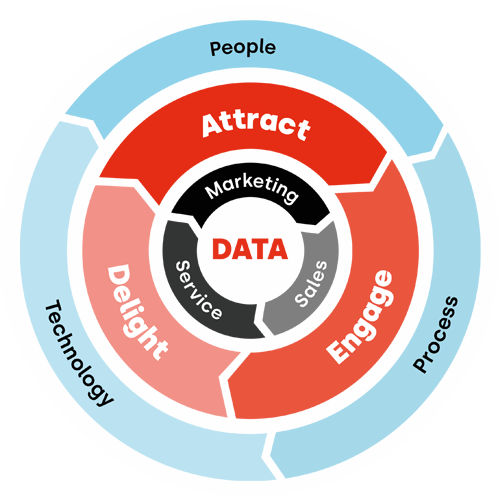The added value of Marketing: Set the clock right with Sales
Soon the clock will be moved again. I don't know if I'm the only one, but it always makes me feel rather restless. It makes me shuffle on my desk chair and tap with my pen. Have we achieved goals? Delivered maximum results? ... Could we have gotten more out of them? This blog will help you in 5 detailed steps to quantify all your marketing actions to get to the table with the C-level in your organization.
If recent research is to be believed, the biggest 3 challenges of B2B marketers are generating website visitors and leads, increasing support for marketing plans and securing sufficient marketing budget for the next year. Do you have sufficient sales and executive support for marketing plans? Is a lack of support perhaps holding you back from doing what you think is important for your organization? If you can express your added value in a way that sales and management can understand, support will follow naturally.

Let's start at the beginning.
1. Establish common definitions across the funnel.
There are several definitions (with high buzzword content) to assign to potential customers moving across your online channels. However, what marketing understands by a "lead" can be substantially different from how sales defines them. This leads to great frustration on your part when sales once again does nothing with the leads provided. But sales is also piqued because marketing provides "worthless" leads.
Step one is therefore: sit down with sales to align these definitions. By showing that you want to speak the same language as sales, you take the first step towards creating support. A start:
 Website visitor
Website visitor
A visitor on your website who has not yet "made themselves known.
Lead
A contact, either self-converted or manually added to your contact database.
Marketing Qualified Lead (MQL)
A lead that meets predetermined requirements set by marketing and sales, therefore fitting within your company's ideal customer profile (think function, revenue, type of company, etc.) Establish buyer personas to determine which individuals make up the DMU (decision making unit) for your organization and which leads are therefore actively picked up by marketing.
Sales Qualified Lead (SQL)
An MQL that is ready to be handed over to sales (e.g. in the form of an appointment) based on 'behavioral requirements' determined in advance by marketing and sales (think: has shown interest by downloading the whitepaper, downloads specs of a machine, views pricing pages on the website, etc. See also: point 4).
Closed deal
A paying customer.
2. Set goals jointly.
You have established common definitions. But now it really begins. How can you make marketing from 'cost center' to 'profit center' (in the eyes of sales and management)?
As a marketer you must, and want to, make an active contribution to the growth of the organization. Let's not make it more complicated than it is: growth essentially always equals paying customers. So you can indeed express the contribution of marketing to the organization in numbers! And that is the language that sales and management understand.
Marketing goals can easily be defined by doing the math. Do you know how many new customers your sales colleagues want to bring in (closed deals) within a certain period of time, then you can start formulating how marketing can contribute to bringing in that customer. This is also called reverse engineering the sales funnel .
In doing so, go through the following steps.
Determine the contribution of marketing in percentages
B2B companies are generally very sales-driven. Whereas the marketing department often consists of one person, the company regularly has dozens of colleagues in sales.
Sales works on the basis of targets and knows very well how many orders they need to bring in per year/quarter/month to achieve the desired turnover. Therefore, the first step is to determine the percentage that marketing will contribute to achieving this desired revenue. 100% is not realistic, because sales will remain active in acquiring customers even without the contribution of marketing.  The total revenue per year (e.g., 10 million euros) times the percentage in which marketing contributes to this revenue (e.g., 40%) determines the amount that marketing will contribute in revenue (in this case, 4 million euros per year).
The total revenue per year (e.g., 10 million euros) times the percentage in which marketing contributes to this revenue (e.g., 40%) determines the amount that marketing will contribute in revenue (in this case, 4 million euros per year).
Determine how many deals will be closed thanks to active contribution of marketing
Next, express a customer in an average order value. Then you can calculate how many customers marketing should generate based on the percentage they contribute to revenue.  Divide marketing's contribution (4 million euros) by the average order value in euros (for example, 50,000 euros per machine sold) determines the desired number of customers at the bottom of the funnel (in this case, 80 customers/orders per year).
Divide marketing's contribution (4 million euros) by the average order value in euros (for example, 50,000 euros per machine sold) determines the desired number of customers at the bottom of the funnel (in this case, 80 customers/orders per year).
Determine how many website visitors and leads you need at each stage of the funnel
Then, using a conversion model, calculate from the number of customers (80 closed deals) back to the number of qualified Sales Qualified Leads (SQLs) that sales needs to make connection (such as a BANT call or an initial appointment). Repeat for conversion from MQL to SQL, Lead to MQL and website visitor to Lead. So you are working from the bottom of the funnel to the top of the funnel.
For example:
- 15% of Sales Qualified Leads convert into a customer (closed deal). This is because when sales engages with a Marketing Qualified Lead, it does not immediately mean that they will become a customer. You need 533 SQLs to close 80 deals in this example.
- 30% of Marketing Qualified Leads (ideal customer profile) will become a Sales Qualified Lead. Not every customer, even if they fit your ideal customer profile will be able to be transferred to sales. You need 1776 MQLs in this example to get 533 SQLs.
- 45% of the leads fit within your ideal customer profile (Marketing Qualified Lead). Leads can include students, for example, or small businesses that can't afford your product. They will never end up becoming customers. You need 3946 leads to get 1776 MQLs in this example.
- 35% of website visitors will become leads. This means you need 11274 website visitors per year to get 3946 leads.
Note! Even though you can find average conversion rates online that can get you started, they will vary tremendously from industry to industry! So don't blindly adopt conversion rates from examples, but dive into your current numbers to find out these rates for your own business. Take these numbers as a benchmark.
This simple method will give you very concrete numbers and at the same time is the second step in speaking the same language to your sales colleagues.
3. Document your strategy: set KPIs
Of course, setting goals makes little sense if you cannot measure whether and how certain goals are achieved. Key Performance Indicators (KPIs) are indicators that help you periodically measure whether set goals are being achieved, and what things contribute to achieving those goals.
The following 3 key metrics determine whether set goals are achieved:
- The number of website visitors per month
- The number of leads (contacts) per month
- The number of closed deals (customers) per month

But is this enough?
Of course, you'd also like to be able to identify which marketing efforts are producing results. Don't do this on gut feeling, but let numbers guide your prioritization. For example, when you don't have enough website visitors, finding out the traffic source can be interesting. However, when you have enough website visits but these visitors don't seem to convert into leads, the conversion rate of landing pages can become interesting again.
The following metrics can tell you how set goals are met:
- What is the bounce rate (the lower, the better) on key pages
- View-to-click ratio on Calls to Action on your website
- Number of website visitors per traffic source (traffic source)
- The number of times clickedon Calls To Action on your website
- How many of these leads fit within the ideal customer profile (= MQL)
- The conversion rate of landing pages (from visitor to lead)
- Which pages in your website enjoy the highest conversion rates
- Et cetera.
4.Agree on processes: establishestablish an SLA
It's time for step 4. Definitions, goals and "metrics" have been established. But who or what determines when an MQL is ready to be turned over to sales (SQL)? Lead Scoring allows you to assign value to each individual lead based on predetermined criteria. This prevents you from transferring leads to sales "on gut feeling. With the data (explicit) and the online behavior (implicit) you can assign a certain score to each lead. You do this again in collaboration with sales.

You have now established when an MQL (marketing) is ready to be transferred to sales (SQL). But how long does sales have to follow up on an SQL? And;should the potential customer not yet be ready to buy, how do you bring it back to marketing so it can possibly lead to business later?
A Service Level Agreement (SLA) is an alignment of tasks between marketing and sales that secures these kinds of issues. You also draft the SLA together with sales to make sure everyone agrees on the tasks and responsibilities. An important part of an SLA is a clear follow-up model. The follow-up model helps both departments work together to recognize, prioritize and follow up on leads.
5. The final step to support: document and adjust
With documentation, you not only support yourself and your marketing team, but also ensure support from sales and management time and time again. Consider the results from steps 1 to 4 as a benchmark; keep track of the analytics on a weekly, monthly or quarterly basis in order to adjust the results.
Documenting for yourself: you continuously have the set goals in sharp focus, allowing you to ask yourself daily the question, "are these actions contributing to achieving goals or not?"
Documentingfor sales and management: documentation helps you secure agreements made. The document justifies your daily actions. Sales and management understand why certain actions are necessary to achieve specific goals, thanks to your argumentation (supported by figures).
Adjust: you might find out along the way that important KPIs are missing, that sales targets are adjusted by management or that new markets are tapped into. Therefore, a documentation is never static. Let the numbers guide you, adjust where necessary and: use your common sense.
Tip: Instead of working with dozens of separate tools that don't talk to each other, consider HubSpot's Marketing and Sales software. The software helps you - provided you have the right processes in place! - track, measure and quantify the successes of Marketing and Sales. This is how you demonstrate your added value to your management and board of directors.
The clock is right with sales ... and now?
By working intensively with sales on common goals, processes and tasks, you will make great strides in gaining support for your marketing plans.

Want to get the most out of HubSpot? Subscribe to our newsletter, follow us on LinkedIn, or attend our HubSpot User Days!
Explore HubSpot User DaysShare this
You May Also Like
These Related Stories

From sales funnel to modern marketing flywheel: switch?

Sales and Marketing: 8 tactics for better collaboration


